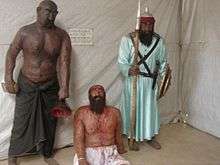Bhai Taru Singh
Bhai Taru Singh (c. 1720[1] – 1 July 1745) was a Sikh martyr.
Biography

Born c. 1720 in Amritsar during the reign of the Mughal Empire, Bhai Taru Singh was raised as a Sikh by his widowed mother. During this time, Sikh revolutionaries were plotting the overthrow of the Mughal governor of Punjab, Zakaria Khan. Bhai Taru Singh and his sister gave food and other aid to the Gursikhs. An informant reported them to Zakaria Khan, the governor of Punjab, and the two were arrested for treason. Though his sister's freedom was bribed for by the villagers, Bhai Taru Singh refused to seek a pardon.[2]
Bhai Taru Singh had partaken amrit from Bhai Mani Singh and was much influenced by him. When he was caught along with his sister. many Sikhs offered to rescue him as they were famous to attack in the midnight in those days. Bhai Taru Singh However said that he wanted to show Mughals that Sikhs are not afraid of death. However at much convincing he allowed his sister to be rescued. Sikhs and villagers paid bribes and got his sister rescued. After a period of imprisonment and torture, Bhai Taru Singh was brought before the Khan and asked him where he got his powers from to undergo all of the agony. His reply was through his Keshas given by Guru Gobind Singh. Zakaria Khan then gave him the choice of converting to Islam or having his hair cut off. In response to having his hair cut off, Bhai Taru Singh said that Zakaria Khan would be killed by Bhai Taru Singh's shoe.
The exact method of Bhai Taru Singh's execution is unclear. Sikhs believe he had been returned to prison to await a slow death. Holy water from Amritsar was brought after 22 days and put on his head to begin his last rites. Zakaria Khan was stricken with unbearable pain and the inability to urinate. As a last resort, Khan sent an apology to the Khalsa Panth for his persecution of Sikhs and begged for forgiveness. It was suggested that if Khan hit himself with Singh's shoes, his condition might be lifted. Although the shoe cured the Khan's condition, he died 22 days later from having hit himself with the shoes, which is what Singh had predicted. Upon hearing that he had outlived the Khan, Singh left his body on 1 July 1745.[3]
A more elaborate version of this narrative includes attempts by the Khan's barber and cobbler to forcibly cut off Singh's hair and, failing that, his scalp. God prevented them from touching him with their tools, and finally a carpenter was brought in to cut off his head with an adze.[4] In other variations of the story, the top of the skull was removed with the hair and scalp.[2][5]
Legacy
In 1762 A.D., the Bhangi Sikh Sardar army conquered Lahore and took over the public square where Bhai Taru Singh was scalped. The Abdullah Khan Mosque adjacent to the square was also occupied and converted into Shaheed Ganj Gurdwara.[6] Today Bhai Taru Singh is viewed by Sikhs as a martyr and a symbol of the importance of Kesh and of steadfast faith. A gurdwara in the Naulakha Bazaar in Lahore marks the place where his scalp and hair was removed.[3]
Trivia
A print representing Singh's martyrdom is present in the 2007 film The Darjeeling Limited, in a scene set in a Sikh temple. [7]
See also
References
- ↑ "Sikh Martyrs – Bhai Taru Singh". Search Sikhism.
- 1 2 "Martyr:Bhai Taru Singh". Sikh Link. Archived from the original on 1 December 2008. Retrieved 12 November 2016.
- 1 2 Iqbal Qaiser. "Gurudwara Shaheed Ganj Bhai Taru Singh". All About Sikhs. Archived from the original on 2006-11-05.
- ↑ Ian Talbot (2000). India and Pakistan: Inventing the Nation. Hodder Arnold Publishing. p. 54.
- ↑ "Bhai Taru Singh". Guru Nanak Sikh Museum.
- ↑ Masjid Shahid Ganj Mosque vs Shiromani Gurdwara Parbandhak ... on 2 May, 1940
- ↑ https://www.youtube.com/watch?v=Xc0rHJ3zY7A